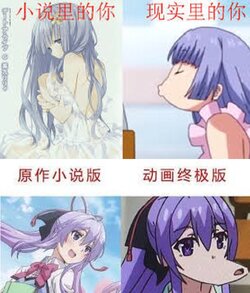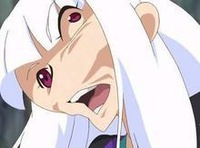
|
Translation in progress This article is currently being translated; it may be incomplete, inaccurate or obfuscating. Moegirlpedia hopes that you can help with translating, proofreading, or copy editing this article. Progress:
75% This template was placed on March 2, 2023 4:04 PM. The last edit was on 20:08, 02 March 2023 (UTC). |
 | |
| Base Info | |
| Term | Sakuga houkai ( |
|---|---|
Sakuga houkai refers to an occasion that occurs during production of an anime where the quality of an anime decreases notably, with factors such as distorted characters, wrong structure or logic, or rough background.
History
The earliest trace of a large-scale houkai is the 1998 "Cosmic Police", in the fourth sentence (subtitle "coconut crab competition") there are problems such as inconsistent audio and video, the disappearance of items.
The 1999 anime film Gundress brought the houkai to film, with low-level mistakes such as sudden blackening and misalignment, in addition to monochrome coloring. The reason was that the production management was out of control, and the film was released in a mostly unfinished state after being subcontracted by Toei, Nikko, Sanctuary, and Studio Junio, which failed to deliver on schedule.
The work "MUSASHI -GUN Road-", created in 2006, is infamous for containing sakuga houkai everywhere, such as the main character Musashi's face looking different in every word, directly taking a photo for the background, and weirdly-animated fight scenes.
Generally speaking, when there is sakuga houkai during the original broadcast or movie screening, it will be fixed in the later release of DVD or Blu-ray. There are very few cases where the houkai version is released in its raw state, like "MUSASHI-GUN-DO".
It is worth noting that the term now has a tendency to be overused. Some shots do not cause a sense of dissonance when watched normally, and only when slowed down or even paused will you notice a slight problem with the artwork. But then there are still a lot of nitpicks and comments accusing a work of sakuga houkai.
Reasons for sakuga houkai

Direct causes of sakuga houkai are generally: the proportion of the production of sub-screening, positioning errors; the original painting of the artist or the complementary frame itself has a problem; screen synthesis, due to layer order, positioning errors, etc. resulting in composition errors; and so on.
But large-scale houkai often have other deep-seated causes, such as:
- Even if we sought to outsource, the level of the other party was not good.
- The time is short, and the artwork supervisor has no time to check the picture.
- Inconsistency in artwork style due to different original artists.
- Some projects are not taken seriously, and there is a "lack of funds".
- In a few cases, this is done intentionally in order to give the work a certain exaggerated effect.
Features

- Deformation of the human face (misshapen features, distorted face and confused drawing style, etc.)
- Disproportion of human body parts / disproportion of character and background (such as not in line with the perspective of the lost height, head to body ratio confusion, limb ratio confusion, etc.)
- Violation of normal perception (e.g. left and right painting reversal, bewildering movements, six fingers, lack of shadows, wrong light and shadow, characters hanging in the air, violation of physical laws, etc.)
- Out of shape lines and contours
- Mistakes in close-up painting
Other things include confusion, inconsistency between the image and the prototype (cabbage → ball, vertical road, etc.), photographic mistakes (meaning that the articulation between the painting layer and the background layer is wrong, or the combination of the photographic material and the painting content is wrong), inconsistency between the items (similar to a mismatch, such as the wrong order of arrangement), coloring mistakes, and misplaced layers.
Victims of sakuga houkai
| |||||||||||||||||||||||||||||||||||||||||||||||||||||||||||||||||||||||||||||||||||||||||||||||||||||